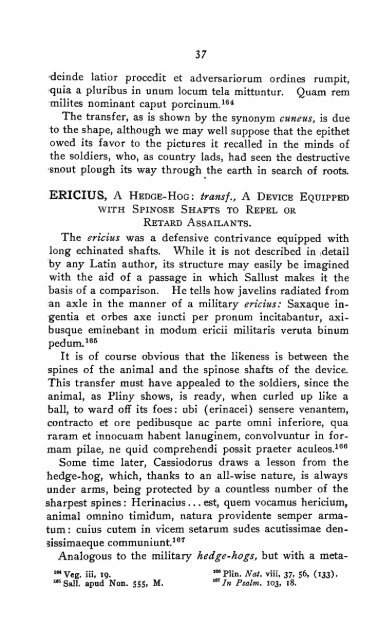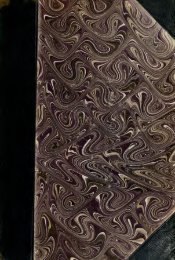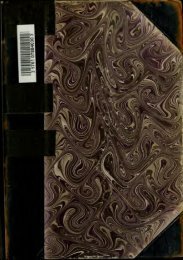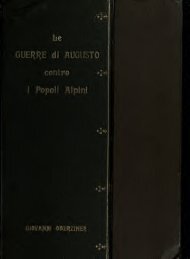Figurative uses of animal names in Latin and their ... - mura di tutti
Figurative uses of animal names in Latin and their ... - mura di tutti
Figurative uses of animal names in Latin and their ... - mura di tutti
Create successful ePaper yourself
Turn your PDF publications into a flip-book with our unique Google optimized e-Paper software.
37<br />
tle<strong>in</strong>de latior proce<strong>di</strong>t et adversariorum ord<strong>in</strong>es rumpit,<br />
quia a pluribus <strong>in</strong> unum locum tela mittuntur. Quam rem<br />
milites nom<strong>in</strong>ant caput porc<strong>in</strong>um.^®*<br />
The transfer, as is shown by the synonym cuneus, is due<br />
to the shape, although we may well suppose that the epithet<br />
owed its favor to the pictures it recalled <strong>in</strong> the m<strong>in</strong>ds <strong>of</strong><br />
the sol<strong>di</strong>ers, who, as country lads, had seen the destructive<br />
snout plough its way through the earth <strong>in</strong> search <strong>of</strong> roots.<br />
ERICIUS, A Hedge-Hog: iransf., A Device Equipped<br />
WITH Sp<strong>in</strong>ose Shafts to Repel or<br />
Retard Assailants.<br />
The ericius was a defensive contrivance equipped with<br />
long ech<strong>in</strong>ated shafts. While it is not described <strong>in</strong> (detail<br />
by any Lat<strong>in</strong> author, its structure may easily be imag<strong>in</strong>ed<br />
with the aid <strong>of</strong> a passage <strong>in</strong> which Sallust makes it the<br />
Lasis <strong>of</strong> a comparison. He tells how javel<strong>in</strong>s ra<strong>di</strong>ated from<br />
an axle <strong>in</strong> the manner <strong>of</strong> a military ericius: Saxaque <strong>in</strong>-<br />
gentia et orbes axe iuncti per pronum <strong>in</strong>citabantur, axibusque<br />
em<strong>in</strong>ebant <strong>in</strong> modum ericii militaris veruta b<strong>in</strong>um<br />
pedum. "^<br />
It is <strong>of</strong> course obvious that the likeness is between the<br />
sp<strong>in</strong>es <strong>of</strong> the <strong>animal</strong> <strong>and</strong> the sp<strong>in</strong>ose shafts <strong>of</strong> the device.<br />
This transfer must have appealed to the sol<strong>di</strong>ers, s<strong>in</strong>ce the<br />
<strong>animal</strong>, as Pl<strong>in</strong>y shows, is ready, when curled up like a<br />
ball, to ward <strong>of</strong>f its foes: ubi (er<strong>in</strong>acei) sensere venantem,<br />
contracto et ore pe<strong>di</strong>busque ac parte omni <strong>in</strong>feriore, qua<br />
raram et <strong>in</strong>nocuam habent lanug<strong>in</strong>em, convolvuntur <strong>in</strong> formam<br />
pilae, ne quid comprehen<strong>di</strong> possit praeter aculeos.-"'®<br />
Some time later, Cassiodorus draws a lesson from the<br />
hedge-hog, which, thanks to an all-wise nature, is always<br />
under arms, be<strong>in</strong>g protected by a countless number <strong>of</strong> the<br />
sharpest sp<strong>in</strong>es : Her<strong>in</strong>acius . . . est, quem vocamus hericium,<br />
<strong>animal</strong> omn<strong>in</strong>o timidum, natura providente semper armatum<br />
: cuius cutem <strong>in</strong> vicem setarum sudes acutissimae densissimaeque<br />
communiunt.^*^<br />
Analogous to the military hedge-hogs, but with a meta-<br />
"*Veg. iii, 19. '"Pl<strong>in</strong>. Nat. viii, 37, $6, (133).<br />
"=8111. apud Non. 555, M. ""/» Psalm. 103, 18.



![Das Kriegswesen der Alten [microform] - mura di tutti](https://img.yumpu.com/21606999/1/167x260/das-kriegswesen-der-alten-microform-mura-di-tutti.jpg?quality=85)








